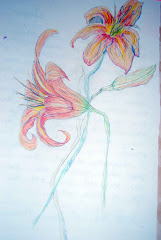






I wandered yesterday amongst the paths of the Saratoga Spa State Park, and wondered at our great fortune to have such a jewel in our midst! I went by myself, so I was free to roam wherever the impulse pulled me, and I found myself drawn to my old favorites once more. My most favorite path is a very short one, that climbs a gentle hill through a dark and damp wood, and it always put me in mind of a primeval forest. The many exposed roots are gnarly; a giddy brook babbles down the hill, leaving rounded boulders glossy with moss; the trees lean in over the path, as though to whisper their secrets. Though it has been recently groomed (the beginning of the path has been widened, and the area at the bottom of the hill, cleared) for the most part it, has been allowed to remain entirely as nature has left it, and that’s what always makes me wish that the path was longer, for it inspires such elemental feelings of connection to the earth!
But, all of the park is lovely, and even more, it is awe-inspiring for its many expressions of geologic magic. Saratoga has long been known for its healing waters, and the early settlers to this country were not the first to appreciate the waters’ benefits. Native Americans from the 14th century were first aware of the springs, having discovered them during hunting excursions; the game that they were pursuing were attracted to the springs, due to the high salt content; in following their prey, they inevitably discovered the springs as well.
At first, the springs were kept as a highly guarded secret, the Native Americans who visited the springs, regarded them as sacred, a gift from the Great Spirit. But eventually, they began to share their secret with early settlers, and as the years, and centuries, passed the area became renown for the healing powers of the waters. The unwell, lame and infirm flocked here from, literally, all over the world, to bathe in and drink the waters.
The springs in this area are a result of a geologic fault; carbonated mineral water is pushed up from as deep as 1,000 feet below ground level. They originate from a layer of dolomatic limestone, which lies below the shale. The salts in the water are leached from the dolostone, and are infused with carbon dioxide, which causes the characteristic bubble.
This fizziness was nearly the un-doing of the springs, for in the early twentieth century, carbonated drinks had become so popular, that over twenty private companies had drilled wells in the area, to capture the carbon dioxide. In the process, the water table was significantly lowered. Advocates came to the defense of the springs, and eventually the park was formed, the wells capped, and the water table rebounded.
Another of my favorite paths is the one that runs along the geyser, where mineral salts have been mounded into hills; nearby streams glisten red from the high iron content; and close by, a meandering stream filled with small boulders ambles under several bridges.
I barely scratched the surface of the park’s 2,200 acres, and yet my outing was rich and full of images to inspire, and renew, and refresh the spirit!





Wonderful writing! And I'm always enthused by stories of "recovery"--which, hopefully, will be the story of this century as we relearn how to cohabitate with the Earth...
ReplyDeleteI know that dark woodsy path with the pretty stream running along it. And the much larger stream that runs past the geyser and the limestone mound. My favorite places in that park. Thanks for all the information about the history of the springs.
ReplyDeleteGoodness, I didn't know any of that. I am really considering coming up that way next year. I have really enjoyed seeing your neck of the woods from your view point. Lately I have been thinking about a "sense of place" after reading Wendell Berry. I can see you write from that perspective of "place". Thanks for the virtual walk.
ReplyDeleteOne of my favorite places nearby to roam with the camera! By the way, love the sketches as well!
ReplyDelete